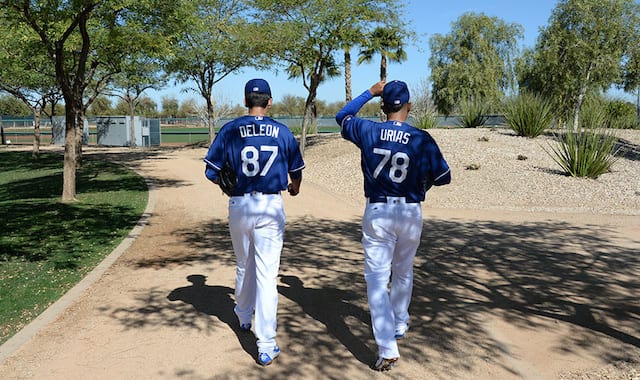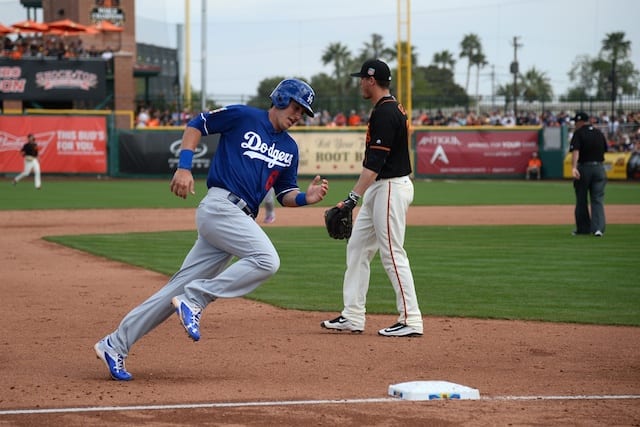
3. Jose De Leon, RHP
In 2013, De Leon was a heavy right-handed 23rd-round pick who was struggling in rookie ball. A year later, De Leon was one of the most surprising stories in Minor League baseball, striking out 42 batters in his final 22.2 innings.
Hard work and a few mechanical tweaks turned him into a legitimate pitching prospect. In 2015, it was more of the same, as he struck out 163 batters in 114.1 innings while posting a 2.99 ERA.
De Leon features a fastball with velocity that’s generally in the low-to-mid 90s, though it can settle in around 90 mph at times. However, he has excellent deception in his delivery which can make it play up.
When he commands it, he’s very hard to hit. Then De Leon adds his plus changeup, which emulates Eric Gagne’s in its action, and he gives hitters fits. De Leon’s slider and curve lag behind, as both currently rate as below average and developing one would greatly help him turn a lineup over.
The Dodgers are holding the young righty back to begin the 2016 season in an effort to limit his innings; this could mean the club plans on using him later in the year.
When De Leon debuts with a Minor League affiliate, he’ll give the Dodgers yet another internal option to solidify the backend of the rotation, and he should compete for a full-time spot next season.
2. Julio Urias, LHP
It may very well wind up that 2012 goes down as a historic year for the Dodgers. Frank McCourt sold the team to Guggenheim, the Dodgers completed a significant trade with the Boston Red Sox, and they added an immense amount of talent through the draft and international signings.
The bigger names include the likes Yasiel Puig, Hyun-Jin Ryu and Corey Seager, but a prospect who flew under the radar was Urias, a stocky Mexican lefty.
The Dodgers waited until Urias turned 16 years old and signed him out of the Mexican League. They sent him to full season ball in 2013, which is unheard of for a player his age. And then he pitched. And everyone wondered who this kid was and how everyone else missed on him.
Over the next two years, Urias reached Triple-A as a teenager, and struck out nearly 11 batters per nine innings in the process. He comes after hitters with a low-to-mid 90s fastball that has touched 97 mph and he commands the pitch well.
On top of that, Urias features a plus changeup with plenty of sink and fade, as well as two versions of a slider — one, a bigger, loopier offering that resembles more of a curveball, and the other is a shorter, more conventional slider.
When he has command of two or three of his pitches, batters are in for a long night. Urias could have built up his workload last season, but opted for cosmetic surgery on his eye in May and ended up missing nearly two months.
Over the last two seasons, Urias hasn’t eclipsed 90 innings during the regular season, so 2016 is important in building up his endurance. He’ll start the season with Oklahoma City and could make his Major League debut later this year.
1. Corey Seager, SS
Seager is a significant prospect in more ways than one. He broke a string of nine straight pitchers the Dodgers selected with their first picks in the MLB draft from 2003-2011, becoming the first position player taken with the club’s top pick since James Loney in 2002.
How he fell to the 18th spot is still something of a mystery. After being drafted, Seager debuted with the Ogden Raptors, where he batted .309 with a .903 on-base plus slugging percentage in 46 games.
He moved up the following season to Low-A Great Lakes, hitting .309 before a late-season promotion to High-A Rancho Cucamonga and a stint in the Arizona Fall League. In 2014, Seager batted .352 in 80 games with the Quakes, then earned a promotion to Double-A Tulsa, where he hit .345 in 38 contests.
Last year, he hit .375 in 20 games for the Drillers before moving up to Triple-A, where he finally came back down to Earth and batted .278. Once the Minor League season ended, Seager received a call-up to the Majors and hit .337 in September.
All told, he’s batted well over .300 as a professional before turning 22. The bat is Seager’s calling card. He exhibits excellent feel at the plate, putting the barrel on the ball with great frequency.
He’s a patient hitter who will use the entire field and covers the plate well. Seager is more of a gap hitter at present time, aiming for the alleys and peppering doubles around the park, but at 6’4 and 215 pounds, it’s hard not to imagine him eclipsing 20 home runs annually.
Defensively, he’s not a standout but he holds his own at short in spite of his size. While his quickness and agility aren’t elite, Seager covers enough ground to make the necessary plays, as well as surprising with the occasional ball up the middle or in the hole.
He does have excellent hands and a strong arm, as well as good instincts. At his size, Seager is not much of a runner but he’ll post solid times while underway. With his offensive profile, Seager figures to be a fixture in the Dodgers’ lineup for at least the next several years, be it at shortstop or eventually third base.
He became the youngest starting shortstop on Opening Day for the Dodgers in 72 years this season, and this figures to be the first of many seasons in which he is featured on the left side of their infield.
You can listen to Jared Massey on the weekly Dugout Blues Podcast.






